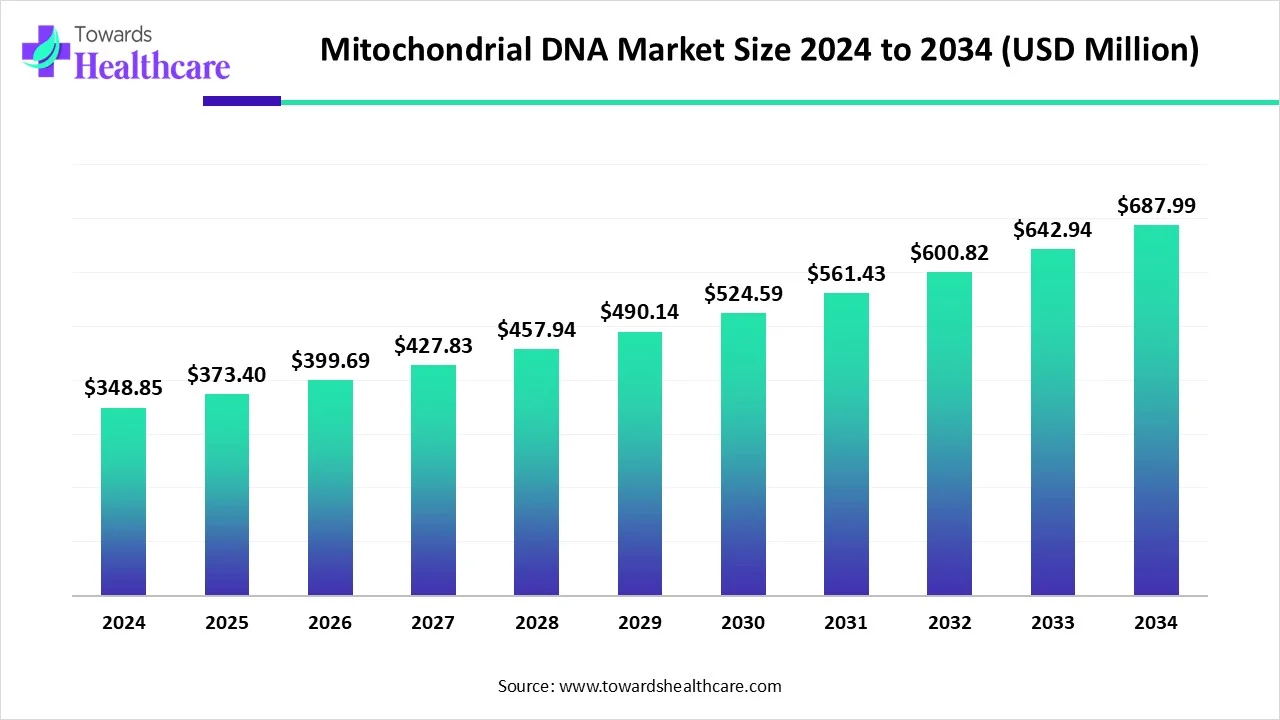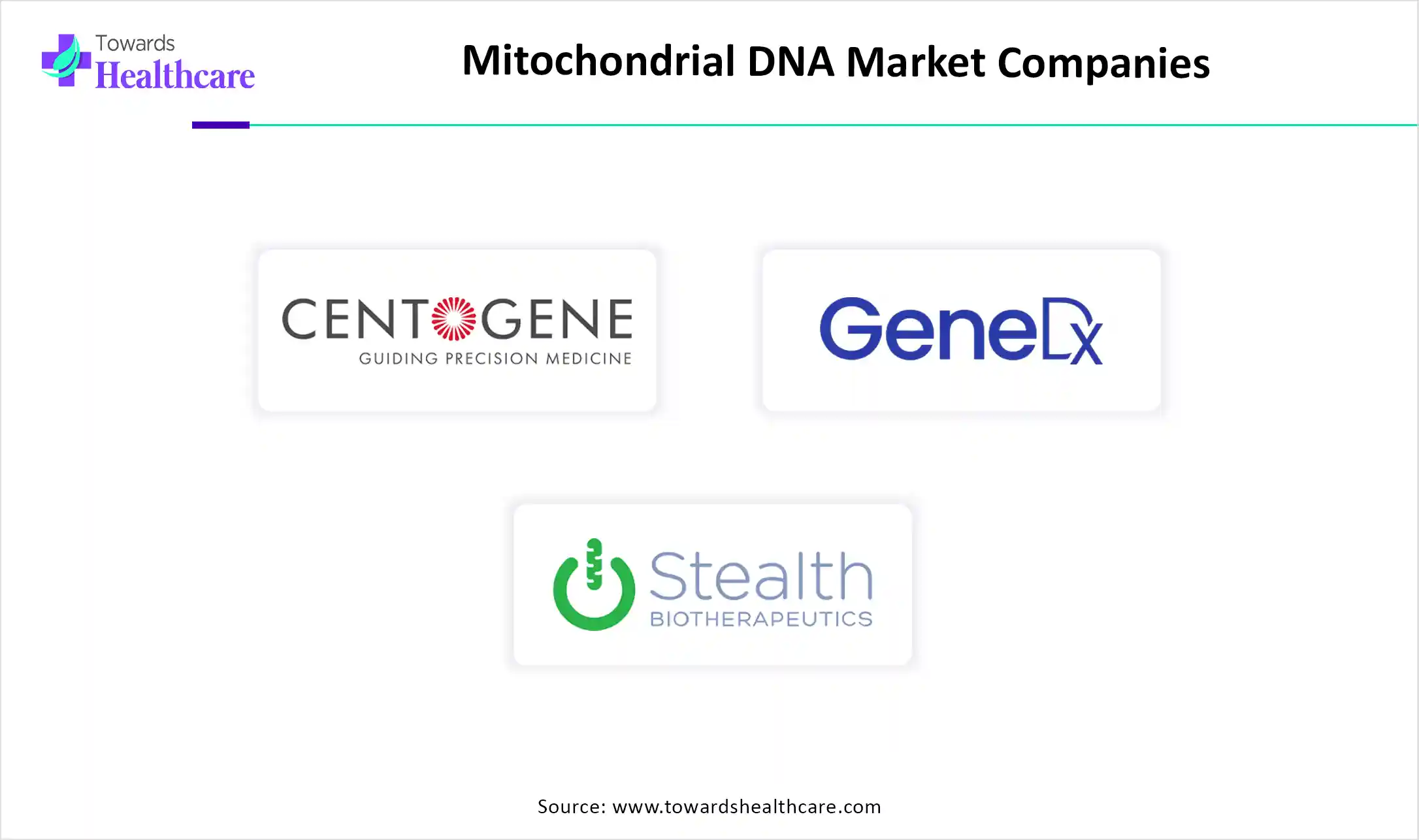October 2025

The global mitochondrial DNA market size is calculated at US$ 348.85 in 2024, grew to US$ 373.4 million in 2025, and is projected to reach around US$ 687.99 million by 2034. The market is expanding at a CAGR of 7.04% between 2025 and 2034.
The mitochondrial DNA market is rapidly expanding because of increasing research in genetic disorders, an aging population, and mitochondrial disease. The growing demand for personalized medicine so it increasing the adoption of next-generation sequencing, which is a key driver of market growth. North America is dominant in the market as applications of mtDNA are growing in forensic science and cancer research. Asia Pacific is estimated to be the fastest-growing region due to the presence of advanced infrastructure and increasing investment in genomics.

The mitochondrial DNA market is rapidly growing because it plays a significant role in the regulation of cellular metabolism, apoptosis, and oxidative stress control. Mitochondrial DNA has special features like a high copy number in cells, a high mutation rate, and maternal inheritance, which have made it attractive to researchers from various fields. Human mitochondrial DNA has developed into a valuable tool in forensic investigations. Its polymorphic nature and maternal inheritance are properties that have, combined with its sequence information, allowed investigators to identify war casualties, recognise missing persons and persons involved in criminal cases and mass disasters.
mtDNA exhibits a distinct maternal inheritance pattern, which means it is typically passed down from the mother to offspring, though in rare cases, paternal mtDNA may also be inherited. mtDNA generally does not undergo recombination, with little to no exchange of genetic material during inheritance, which enables it to more stably retain its unique genetic information.
For Instance,
AI integration in mitochondrial DNA is driving the growth of the market as AI-driven technology analyzes and processes large and complex biological data to support to clarify the consistent pathological and physiological mechanisms and then assist in screening and designing drug molecules and in analyzing clinical trials. Scientists are recently using AI-driven tools to rapidly identify mutations in mitochondrial DNA (mtDNA) or nuclear genes that affect the function of mitochondrial. These technologies analyze thousands of errors simultaneously, flagging the most likely to be disease-causing. AI-powered drug discovery platforms are being applied to predict how diverse molecules might affect the metabolism of mitochondria, energy production, and much more.
For Instance,
Increasing Mitochondrial Disease Cases
The rise in mitochondrial disease cases is primarily due to increased awareness and improved diagnostic methods, leading to more identified cases. These disorders are caused by genetic mutations, with genes providing instructions for protein production. Typically, genes involved in mitochondrial disorders encode proteins that function within mitochondria, but mutations can disrupt this process, affecting the body's protein synthesis. The inheritance pattern of mitochondrial disorders is complex; many cases are sporadic, occurring without any family history. The risk of transmission to offspring depends on multiple factors, which have contributed to the growth of the mitochondrial DNA market.
Major Limitation of mtDNA
The limitations of mtDNA analysis include its inability to provide definitive identification, the presence of heteroplasmy, risks of contamination and paternal leakage, as well as being time-consuming and costly. These factors restrict the growth of the mitochondrial DNA market.
Increasing Application of mtDNA in Neurodegenerative Diseases
Mitochondrial DNA (mtDNA) editing has become a groundbreaking method in combating neurodegenerative diseases (NDDs). As these conditions continue to pose a major global health challenge, innovative mitochondrial gene editing presents a hopeful strategy to target their root causes. Mitochondrial dysfunction, caused by mutations in mtDNA, is now seen as a key factor in the development of serious diseases like Parkinson's disease (PD), Alzheimer's disease (AD), Huntington's disease (HD), and Amyotrophic Lateral Sclerosis (ALS). This also opens up new opportunities in the mitochondrial DNA market.
By drug type, the anti-inflammatory biologics segment dominated in the mitochondrial DNA market in 2024, as biologic therapies have transformed the treatment of patients with severe inflammatory autoimmune diseases and with serious osteoporosis. Mitochondrial DNA is released from mitochondria and triggers the activation of diverse pro‐inflammatory signalling pathways. This creates an opportunity for developing anti-inflammatory biologics that target mtDNA or its related pathways.
The non-steroidal anti-inflammatory drugs (NSAIDs) segment is expected to grow at the fastest CAGR over the forecast period, 2025 to 2035, as NSAIDs are used for the treatment of patients suffering from inflammatory and pain conditions like osteoarthritis, chronic pain, rheumatoid arthritis, postoperative surgical conditions, menstrual cramps and also used widely as anti-pyretic and analgesics. NSAIDs include ibuprofen, aspirin, and naproxen sodium.
By application, the therapeutic segment is dominant in the Mitochondrial DNA Market in 2024, as therapeutic approaches that target mtDNA have considerable implications for anti-cancer drug research and medical treatment. Targeting mtDNA supports overcoming tumor drug resistance and the complete removal of tumors. This is due to the acquisition of some biological physiognomies of tumors is related to mtDNA. mtDNA is a significant component of the cell, and modifications in mtDNA make it an attractive target for therapeutic interventions.
The research and development segment is expected to fastest-growing over the forecast period 2025 to 2035 as mitochondrial DNA (mtDNA) analysis is significant for the finding of mitochondrial disorders, basic research, and forensic investigations. mtDNA sequencing is a significant tool in molecular biology with wide applications in various sectors, specifically in disease research, population and genetics evolution, identification of forensic material, and reproductive medicine research.
By route of administration, the oral segment is dominant in the mitochondrial DNA market in 2024, as this route of administration of drugs is a suitable, affordable, and most commonly used medication administration route. The main site of drug absorption is usually the small intestine, and the bioavailability of the medication is determined by the amount of drug absorbed in the intestinal epithelium.
The intravenous segment is estimated to fastest-growing over the forecast period 2025 to 2035, as administering a drug through the intravenous (IV) route involves the introduction of a drug solution directly into the blood through the vein using a syringe through a needle or a needleless port on an existing IV line or a saline lock (short venous access device). It is the best way to deliver a dose rapidly and accurately, as the drug enters directly into systemic circulation without the delay associated with absorption processes, achieving its therapeutic effect faster than by any other route.
By distribution channel, the hospital pharmacies segment is dominant in the Mitochondrial DNA Market in 2024, as hospital pharmacies are responsible for managing the use of medications in hospitals and other medical centres. It aims to comprise the delivery, procurement, prescription, selection, administration, and review of novel medications to optimize patient results.
The retail pharmacies segment is estimated to fastest-growing over the forecast period 2025 to 2035, as it often provides a wide range of selection of medicines and supplementary health care products, addressing various healthcare requirements. With inclusive services, containing pharmacy and mail order options, retail pharmacies modernize the medication access procedure.
North America is dominant in the drug design tools market with the largest revenue share, as North America is a hub for major renowned research institutions, organizations, and universities dedicated to genomics research and mitochondrial research. The region has made important contributions to cancer genomics, with increasing pharmaceutical R&D spending. The major program is designed to advance medical research on rare diseases by offering help for clinical studies and increasing partnerships, including mitochondrial diseases. Continue increasing demand for genetic testing as many people realize genomic tests help primary disease detection and lifestyle customisation, which contributes to the growth of the market.
For Instance,
In the United States, the growing prevalence of mitochondrial disease has been estimated at 1 in 4000 in this region. 1,000 to 4,000 children in the U.S. are born with a mitochondrial disease, which contributes to the growth of the market. Advances in technology are renovating the way medical care solutions are delivered, from advanced devices that offer earlier diagnoses and recommend personalized treatments, to modern technologies that connect patients and health professionals in a virtual space, contributing to the growth of the market.
In Canada, increasing initiatives to raise awareness for mitochondrial diseases in Canada it is significant for the progress of treatments, increasing research on the disease, and offering support to the patients who have mitochondrial diseases. Canada is a global leader in healthcare research, with a growing advanced health research and innovation ecosystem that drives innovation, addresses various health challenges, and enhances health results for all Canadians, which contributes to the growth of the market.
The Asia Pacific region is projected to experience the fastest growth in the mitochondrial DNA market during the forecast period, due to the rapidly increasing biotechnology research in the Asia-Pacific region, because of enhancements in healthcare infrastructure, helpful government policies, and increasing clinical trial services. Increasing adoption of advanced diagnostics technology improves early detection of mitochondrial diseases in the Asia Pacific region, which contributes to the growth of the market.
China has invested substantially in expanding genomic health care infrastructure, including mitochondrial genome research. It has implemented universal health insurance coverage for its rising old age population. The country has also encouraged equal access to public health solutions by starting a national essential medicine system. China’s medical care sector is experiencing huge growth, driven by growing incomes, rising health awareness, and an aging population.
In India, the increasing diagnostics sector, resulting from growing healthcare requirements in India, is accelerating the mtDNA testing. The growing technological advancements like AI systems, image processing, and automated processes in radiology and pathology need continuous investment in novel equipment and training, which contributes to the growth of the market.
Europe is expected to grow significantly in the mitochondrial DNA market during the forecast period, as the growing government funding to create the advanced genomic healthcare system in Europe will help to save lives and improve health outcomes. For Instance, Horizon Europe is the EU's key funding programme for research and innovation with a budget of €95.5 billion. Recent limited availability of effective disease‐modifying therapies has led to a high rate of mortality and morbidity, so an increasing demand for mitochondrial disease research in Europe.
In the world, Germany is the third-largest healthcare technology sector. Growing medical diagnostic testing because of an aging population, an increasing prevalence of chronic diseases, and the development of recent technology, which drives the mitochondrial DNA market. Strong presence of a biotech firm in Germany. For Instance, 4,100 companies are in the biotech industry, including major, small, and midsize companies, which causes the growth of the market.

In April 2025, Jay Parrish, Ph.D., Chairman of the Board and Chief Executive Officer of Pretzel, “Pretzel Therapeutics initiates phase 1 clinical study evaluating PX578, lead therapeutic in its bioenergetics restoration franchise. The initiation of our Phase 1 clinical trial of PX578 reflects the important progress we are making in turning our unique bioenergetics approach into a reality, with a deep, first-in-class pipeline of energetics restoring and energetics modulating compounds to positively impact high unmet essential indications.” (Source - Businesswire)
By Drug Type
By Application
By Route of Administration
By Distribution Channel
By Region
October 2025
November 2025
December 2025
November 2025